Reims boss Will Still garnered a cult following as the 30-year-old led his team to a 17-game unbeaten Ligue 1 run after taking charge back in October.
However, his team’s unbeaten run finally came to an end a couple of weeks ago, as Marseille toppled Les Rouges et Blancs away from home, claiming a 2-1 victory at Stade Auguste-Delaune.
Now, the title of ‘longest unbeaten run for a Ligue 1 coach’ goes to 36-year-old OGC Nice boss Didier Digard, who’s overseen 12 league games (13 in all competitions) since assuming the Nice hot seat back in early January.
He’s won six of those Ligue 1 fixtures (seven in all competitions) and drawn six.
This piece will combine tactical analysis and data analysis to compare the reigns of the highly respected 65-year-old Lucien Favre, formerly of Bundesliga sides Borussia Dortmund and Borussia Mönchengladbach, among others, and the young up-and-coming coach Digard from their time at Nice in 2022/23.
We’ll analyse where Nice have improved under Digard and what’s changed compared to earlier in the campaign.
Improved defensive performance
Nice have earned an average of two points per game in their 12 matches with Digard so far — an improvement of 0.76 over the 1.24 points per game they managed in 17 fixtures under Favre at the beginning of the campaign.
One key aspect of Nice’s strategy, tactics, and performance that has improved under Digard compared to Favre has been its defensive phases.
At the beginning of the campaign, Nice conceded 19 goals in their 17 games under Favre, an average of 1.12 per 90 minutes.
With Digard in the hot seat, Nice have conceded seven goals in 12 games, an average of 0.58 per 90.
This is obviously a stark contrast.
With that said, Nice’s defensive record wasn’t terrible under Favre — they had conceded the fifth-fewest goals in the league at the time of the Swiss coach’s departure.
However, only Lille have now conceded fewer goals than Nice (26).
Additionally, Nice have the second-lowest xGA (34.11) of any team in France’s top flight.
So, even though Nice weren’t enduring a defensive crisis when he took charge, Digard has engineered a significant improvement in the defensive areas, making Nice one of the most challenging sides in France for their opponents to break down.
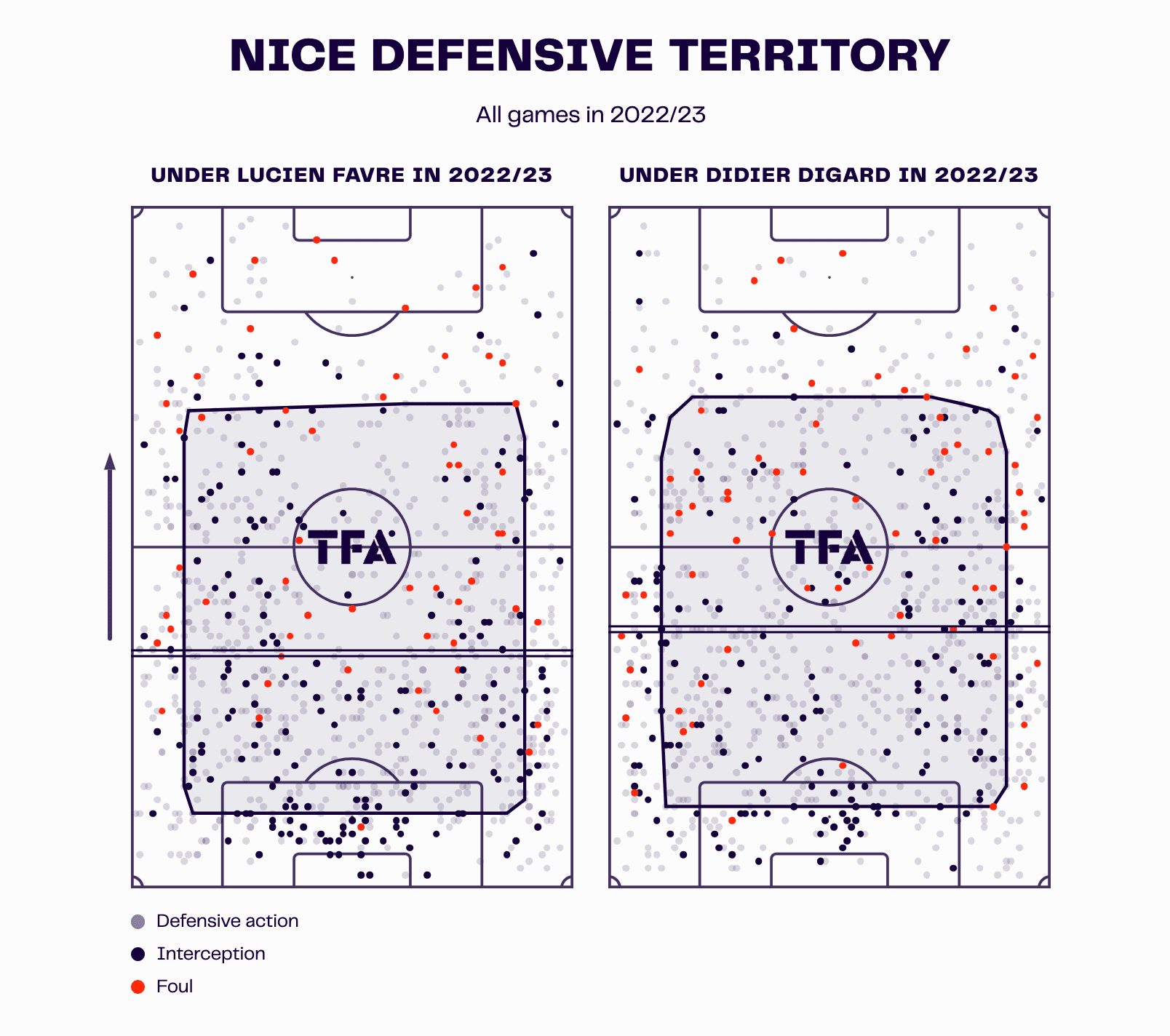
Nice have defended relatively similarly under Digard to how they defended under Favre, though they’ve positioned their defensive line ever so slightly higher in the last 12 games than they had done in the previous 17.
Other than that, the average area of engagement is almost identical.
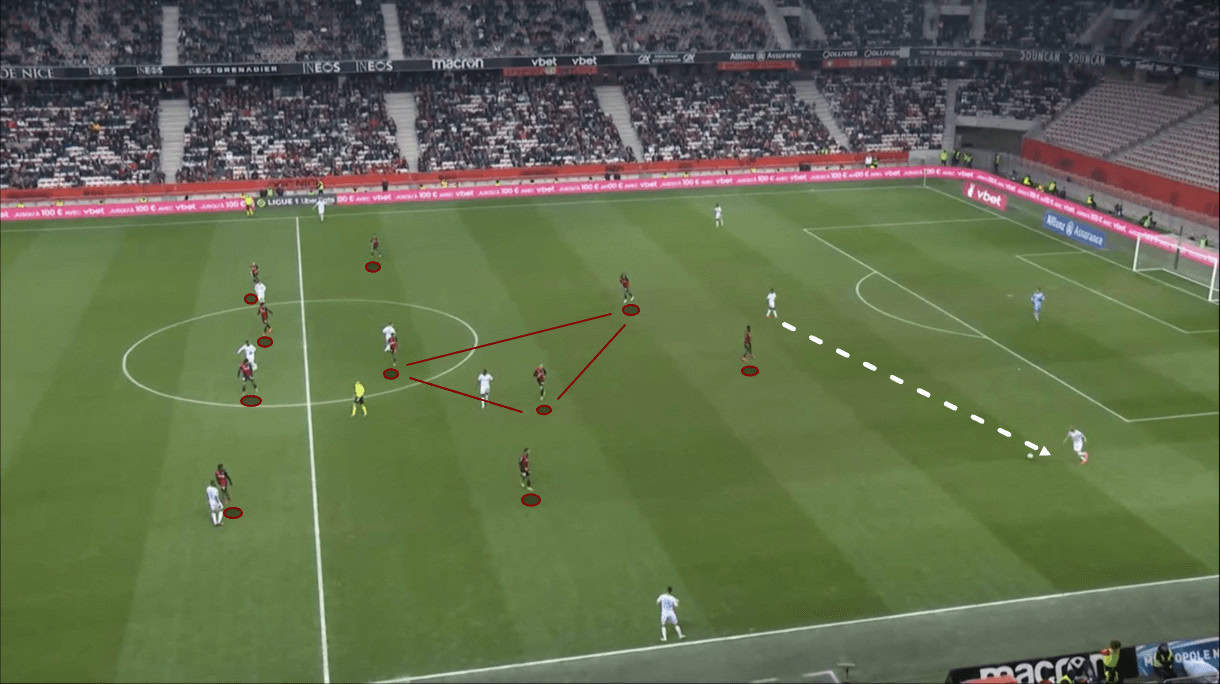
Digard hasn’t been married to a particular shape, changing it up quite regularly since taking charge.
As we see in Figure 2, the most common formation Nice has used to defend with Digard has been a 4-1-4-1.
The centre forward has remained in the position we see him in within this shape, aiming to block off central passing lanes and help force the play into wider areas.
Meanwhile, the central midfielders have the license to press aggressively, helping the centre-forward press the opposition’s backline.
The holding midfielder will primarily focus on picking up opposition players looking to exploit space between Nice’s midfield and defence, but if there isn’t anyone, he too has the license to move higher and help squeeze the opposition inside their half.
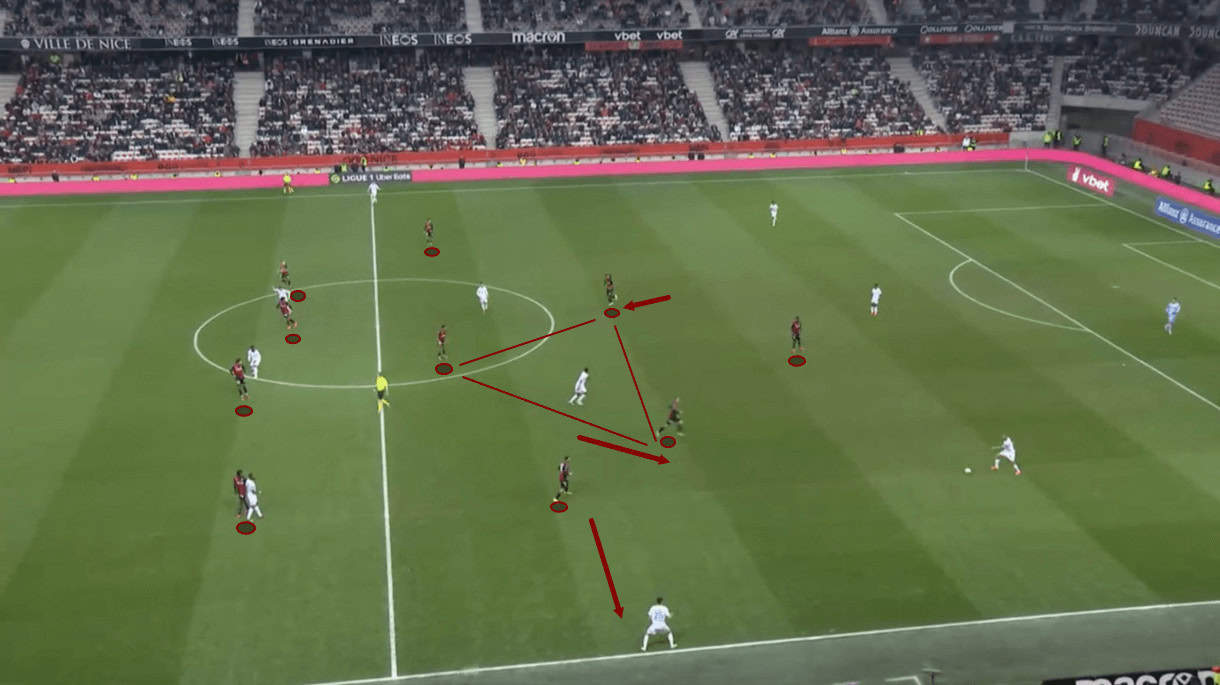
Here, as the play shifts from right to left as we move into figure 3, we see how the left and right central midfielders swap roles, with the left dropping deeper and the right pressing higher.
From here, if the ball moves out wide, we’ll see Nice’s ball-near winger closing in on the receiver, likely receiving some help from the ball-near central midfielder just behind, who’s already positioned well to block off the passing lane into midfield.
Likewise, the ball-near full-back has the more advanced winger covered.
It’s important to note how the ball-far winger remains fairly close to the wing-back on the opposite side, and the ball-far central midfielder, striker and holding midfielder remain central, ensuring this area is protected and they retain access to the opposite wing.
This has been a notable aspect of Nice’s defensive approach under Digard.
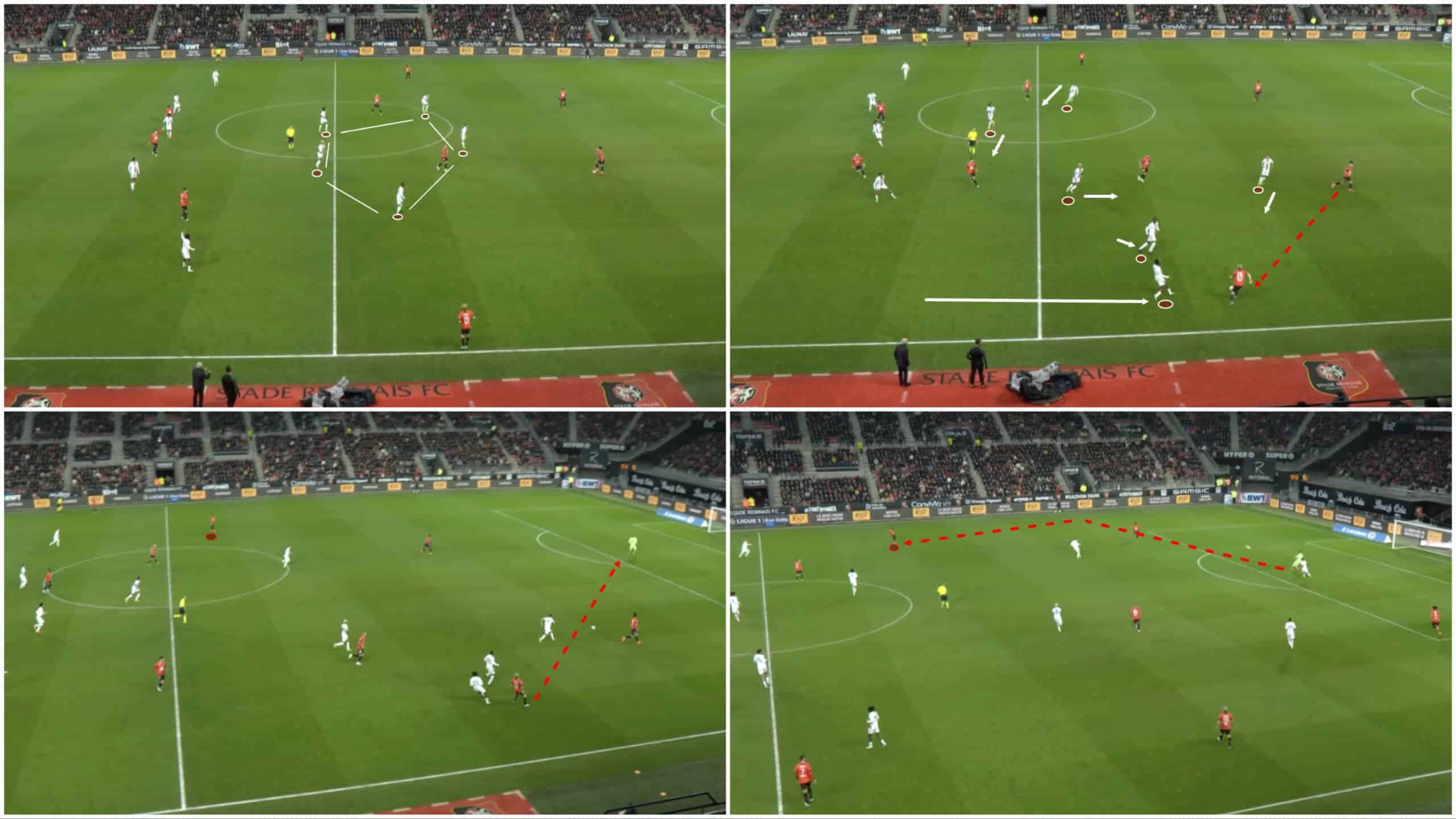
Earlier in the season, Nice placed slightly more emphasis on trying to win the ball back on the wing via aggressive pressing and committing numbers when the ball was played out wide more often, as Figure 4 depicts.
This, at times, left far too much space open on the ball-far wing for the opposition to exploit as they did on this occasion.
We still see this sometimes with Les Aiglons. Digard hasn’t created a perfect defensive strategy — that doesn’t exist — and Favre didn’t have a bad one in his own right.
However, Digard has noticeably helped Nice improve in a specific area in which they demonstrated some weaknesses earlier in the campaign.
This helped them become the team with the second-best defensive record for the entire Ligue 1 season and the second-best team defensively for the last 12 games—Digard’s entire tenure in charge.
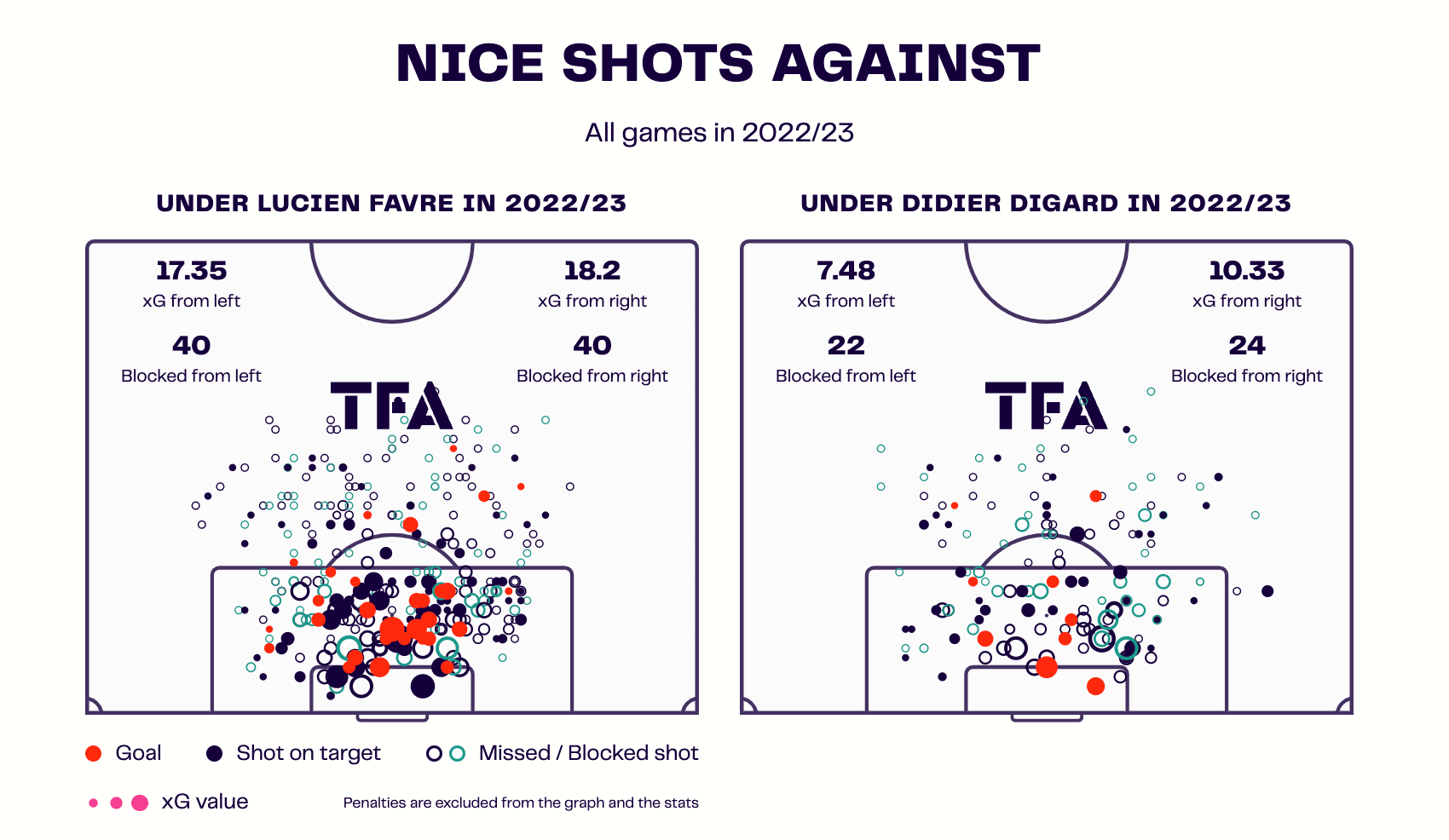
Throughout the season, Nice’s right side of defence has performed worse than the left.
Looking at Figure 5, it’s worth remembering that this data is taken with games from all competitions over the course of the campaign, and there were significantly more games played under Favre than Digard.
That said, we see a healthier ‘shots against’ map in that far fewer of those high xG chances have been conceded recently.
Nice have done well to deny their opponents as much time in their box.
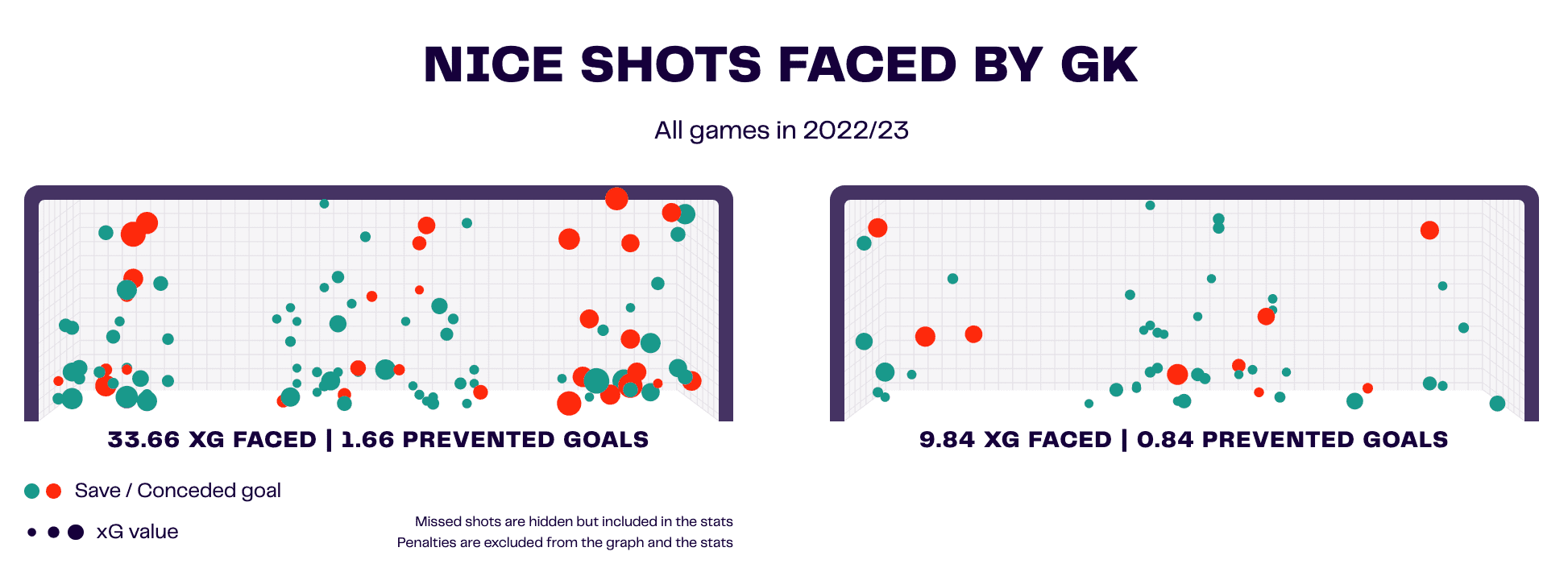
This has seen Kasper Schmeichel face far fewer shots and far fewer xG, meaning he’s been less likely to concede and has had less work to do—a good sign that Nice’s defensive strategy has been working well.
Improved attacking performance
In their 17 games under Lucien Favre this term, Nice scored 16 goals — just under a goal per game.
In the last 12 games, overseen by Digard, Nice
has scored 22 goals—just over 1.8 goals per game.
This difference is staggering; Nice have been about twice as productive in front of goal since changing their manager — and that’s despite Les Aiglons’ second-highest goalscorer this season, on loan from EPL leaders Arsenal Nicolas Pépé, being out of action due to injury for the majority of Digard’s tenure thus far.
The late January signing of Terem Moffi from Ligue 1 rivals Lorient has undoubtedly played a key role in Nice’s impressive run of form under Digard.
Moffi is on course to push the likes of PSG’s Kylian Mbappé and Lille’s Jonathan David all the way to the end of the season in the Ligue 1 Golden Boot race, having bagged 16 goals this season between his time at Nice, so far, and his time at Lorient previously.
Total Football Analysis published a player analysis article looking deeply into Moffi’s game just over a year ago during a period of poor form for the 23-year-old attacker, in which I shared my view on why the then-Lorient coach, Christophe Pélissier, was right to stick by the Nigerian forward.
This piece provides in-depth insight into Moffi’s game, and I’d recommend checking it out if you’re interested in becoming more familiar with the Nice man: ‘Terem Moffi 2021/22: ‘Keeps my confidence’ – why Pelissier stands by ‘woeful form’ wonder – scout report’.
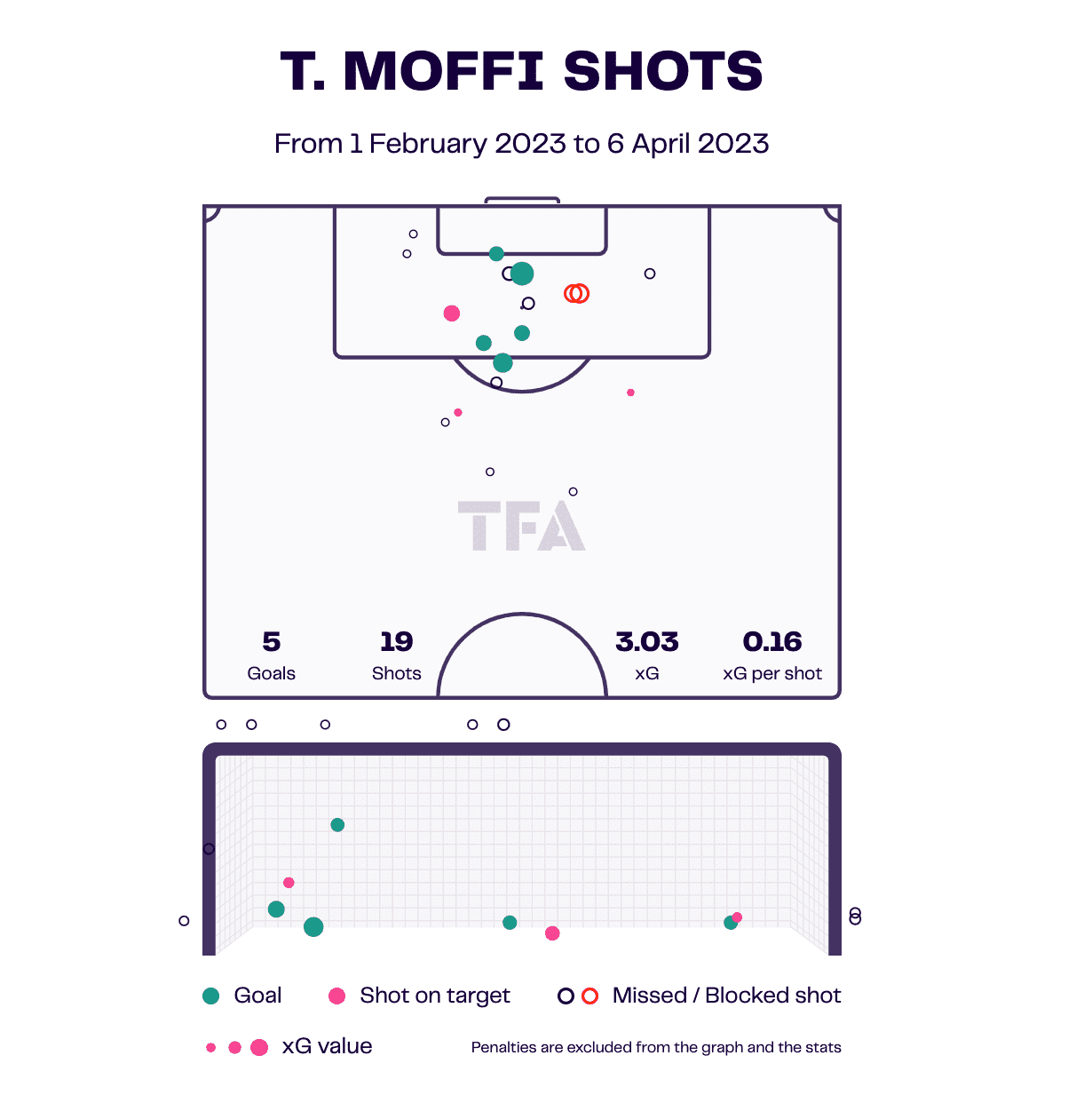
Since joining Nice, Moffi has bagged five goals from 19 shots and an xG of 3.03.
He’s averaged a respectable 0.16 xG per shot during his time with Les Aiglons, and as Figure 7 depicts, his shot selection has generally been very good.
The 23-year-old positions himself intelligently and finishes shots from valuable positions in which his teammates can find him.
Moffi is a tough striker to defend against.
He has plenty of weapons in his arsenal and different ways of hurting the opposition.
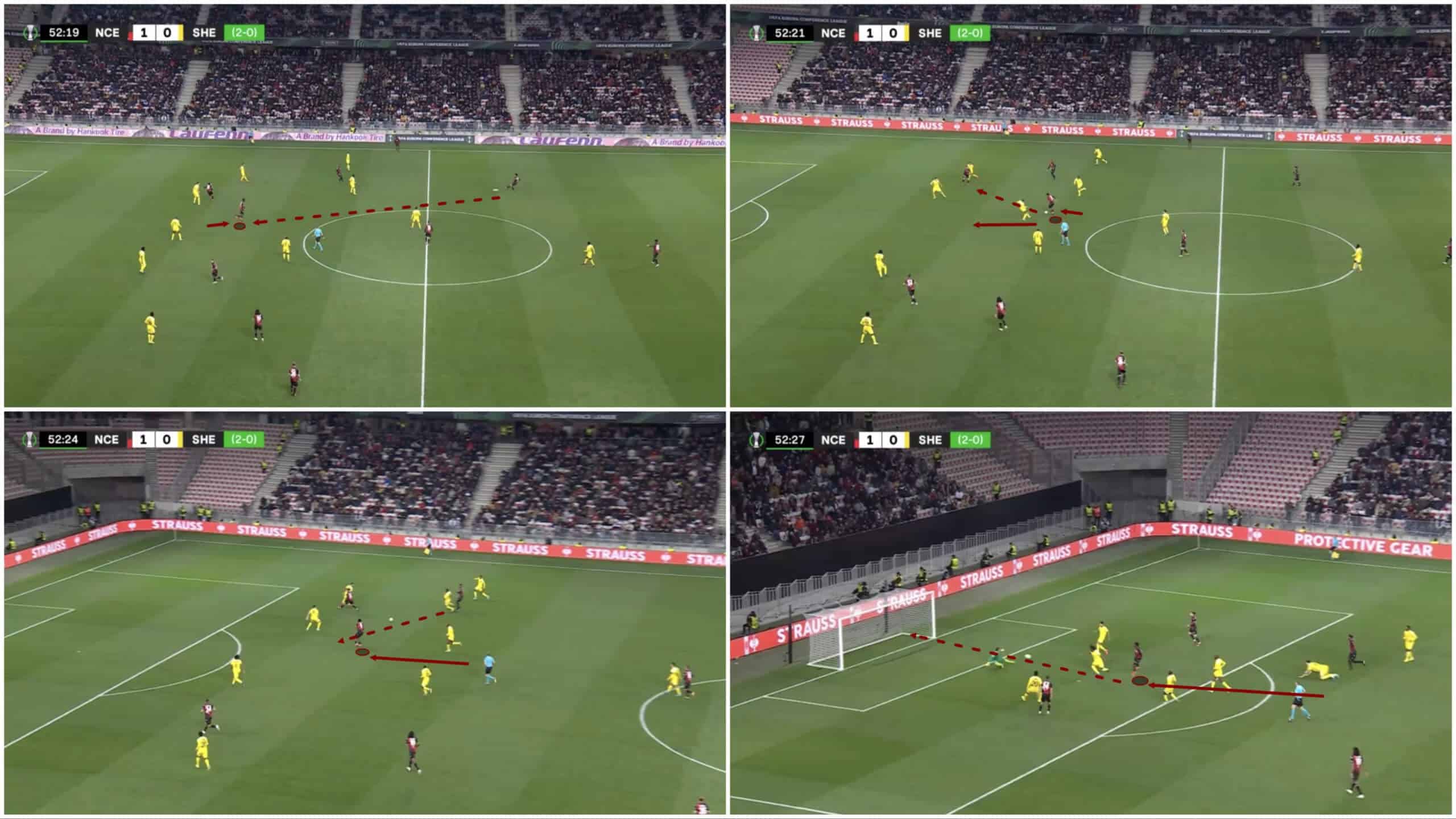
On the one hand, he likes to come short and receive the ball to feet when dropping off from the defence to exploit some space between the lines.
As Figure 8 shows, he’s capable of turning on the ball after receiving in such situations and either linking up with a teammate or going it alone to progress into a goalscoring position.
Moffi loves making these types of runs, whether or not he actually gets the ball—that depends on how the opposition reacts to his movement.
If they stand off and/or just don’t react to his dropping movement, Moffi can receive as he does here.
However, if the opposition reacts and rushes to pick him up, that can create space for a teammate to exploit, as was often the case at Lorient.
We’ll likely see this more and more as the 23-year-old’s new teammates become more used to him and his movement.
Moffi’s ability to use his body as a barrier against defenders is another key aspect of his attacking game that makes him difficult to defend against.
This applies when backing into defenders receiving with his back to goal, when getting onto the end of a cross, or when chasing a ball in behind—all situations in which the Nigerian has proven to be very dangerous at Lorient in the past and with Nice already this season.
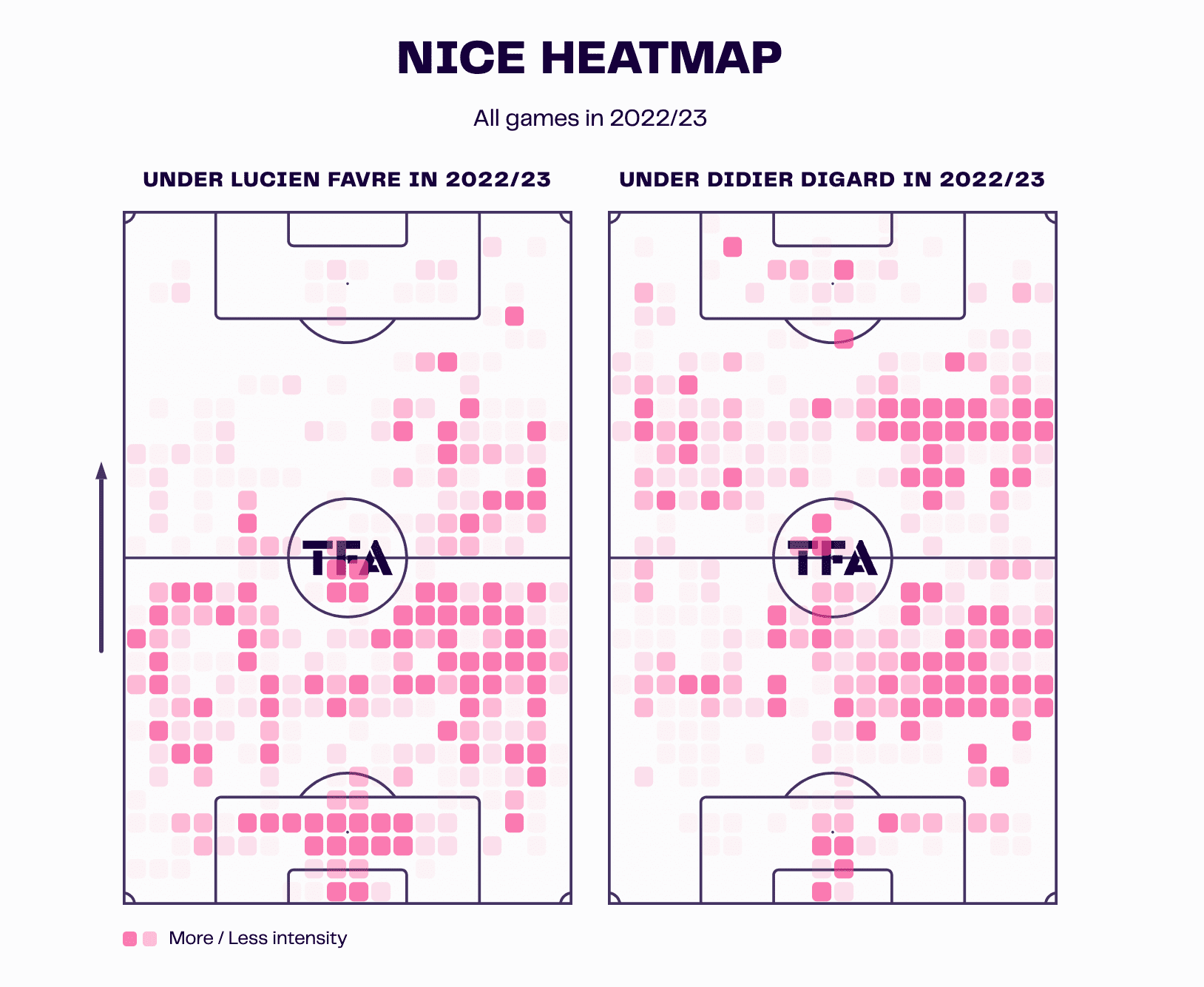
Nice have spent more time in advanced areas of the pitch, in general, under Digard so far than they did under Favre this term, Figure 9 shows Les Aiglons’ heatmap under both coaches in 2022/23 for comparison.
With Favre, Nice spent more time on the ball in deeper areas, whereas, under Digard, they’ve managed to establish possession inside the opposition’s half more often.
Part of the reason for this is the focus of our next section: midfield roles.
Midfield roles
This will be the final section of our analysis.
In this section, we’ll examine how some specific midfield roles have changed at Nice under Digard compared to Favre earlier in the campaign.
We’ll be focusing on two players in particular in this section: Khéphren Thuram and Hicham Boudaoui.
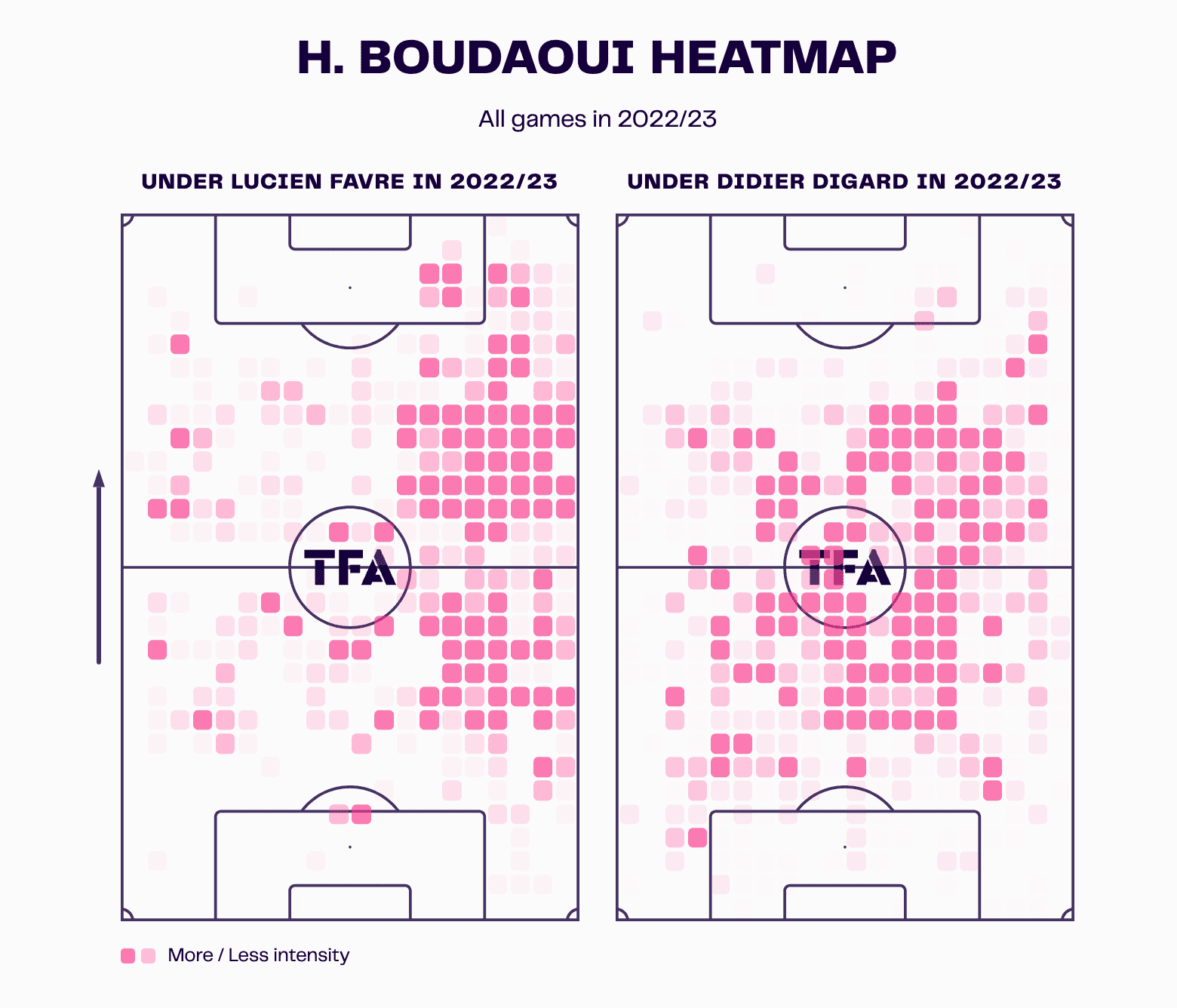
Starting with Boudaoui, figure 10 displays that the Algeria international has played deeper and more centrally under Digard than he did under Favre.
Earlier this season, the 23-year-old played primarily on the right side of midfield — the same position he mainly occupied under current PSG boss Christophe Galtier last season.
However, in the previous campaign, 2020/21, the Algerians predominantly played centrally under Adrian Ursea.
For part of that season, Boudaoui was Nice’s deepest midfielder, while at other times, he was a more advanced central midfielder.
The 23-year-old Paradou academy product is well capable of playing either a more disciplined deeper role or a more advanced role where he has a bit more leeway to get forward and contribute at the business end of the pitch.
But this season, his contribution has been most needed and appreciated by Les Aiglons in that deeper role.
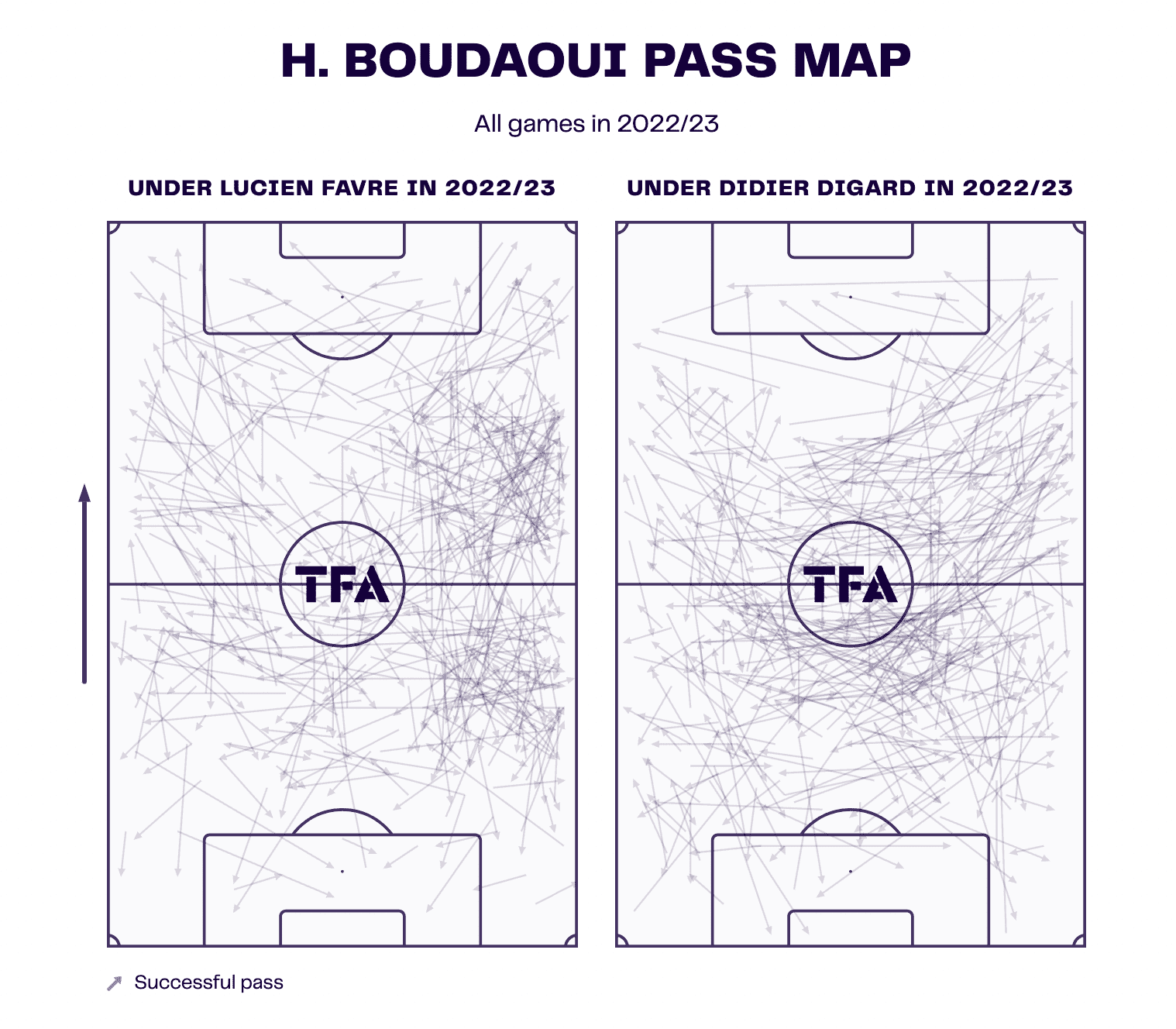
Boudaoui, who teammate and compatriot Billal Brahimi has described as possessing “the best technique” of any Nice player, has played a key role in linking the backline with the attackers and helping Les Aiglons establish more possession inside the opposition’s half since the change from Favre to Digard.
The midfielder is quite one-footed, which hurts him a tad and can make Nice’s attacks a little predictable in certain respects. Other than that, his technique, ability to free himself up centrally in space, and passing quality are of the high standard desired by Nice in this holding midfield position.
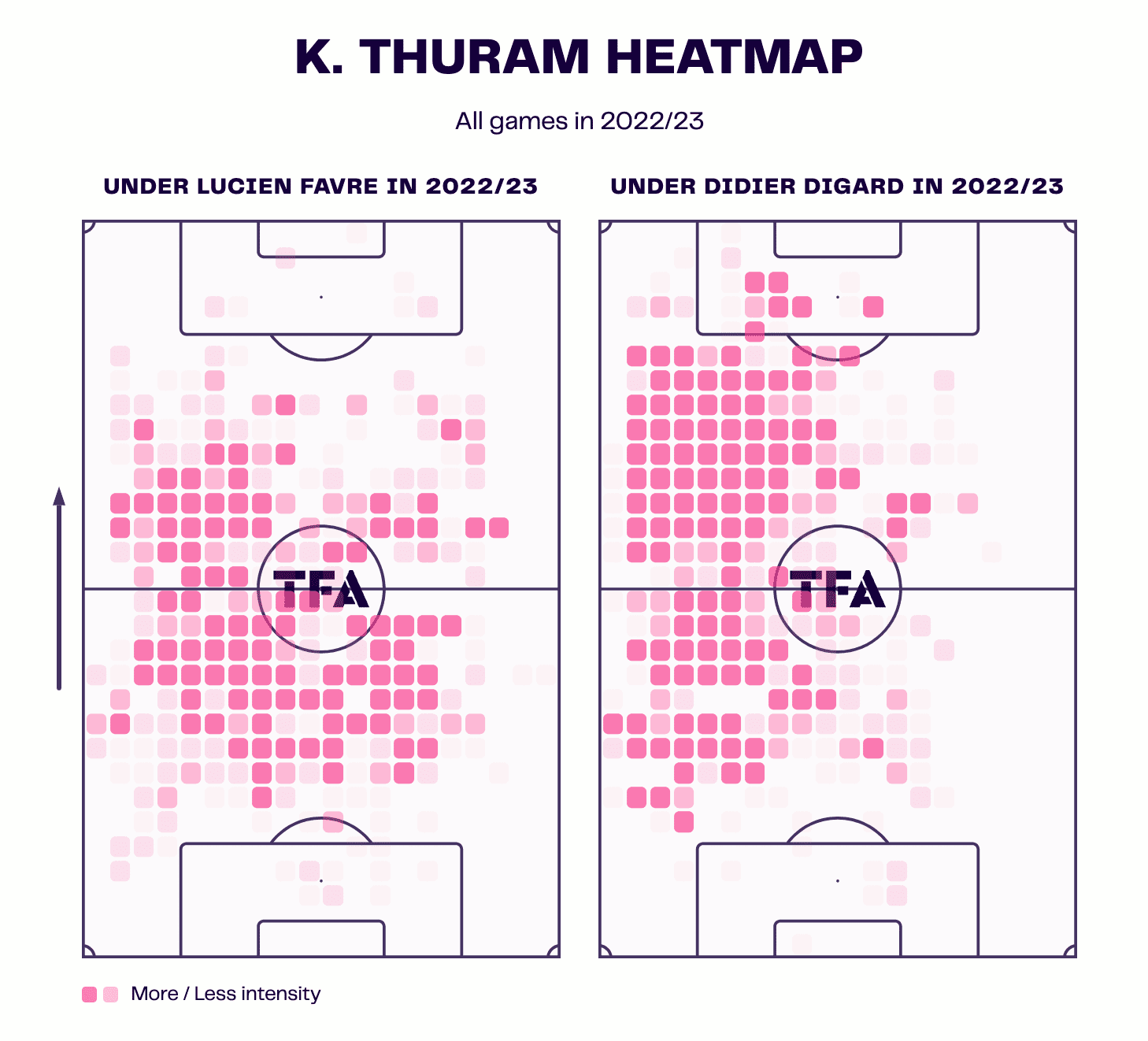
As for Khéphren Thuram, we’ve kind of seen the opposite occur.
Whereas earlier in the season, the midfielder was positioned deeper, he’s moved into a more advanced position on the left side of central midfield since Digard has ascended to the Nice hot seat.
Thuram is another who’s capable of becoming a top-holding midfielder or a top central midfielder, but he’s certainly shone when playing in a more advanced position this season.
For me, this is where he’s at his best, with freedom to carry the ball forward and aggressively press on the front foot rather than being anchored to the backline and picking up players who look to exploit the space opening up between the lines.
In 2020/21, Thuram mainly played in a deeper midfield role similar to the way he played at the beginning of this season, while last term, we saw him move up into advanced positions on the left side much more often.
He’s returned to this in the latter part of the 2022/23 campaign, and he’s seemed reinvigorated by that.
Thuram is good at playing defence-splitting passes in the final third.
He doesn’t make a tonne of shot assists but does provide plenty of second assists; it’s common to see him slicing the defence open and sending the ball through for an attacker to then tee it up on a plate for the striker to finish from a more central position.
The 22-year-old midfielder’s role in this is crucial and a big part of why I really like him when played more like an ‘8’ or at least in a two-man midfield with the freedom to roam.
We’ve seen a lot of that from him over the second half of the 2022/23 campaign.
Conclusion
To conclude our analysis, Nice has been second in the Ligue 1 form table for the last 12 games, trailing only Will Still’s Reims.
This is the same period that encapsulates all of Digard’s time in charge of Les Aiglons, and it’s clear the 36-year-old coach has engineered significant improvements at the Allianz Riviera, both with and without the ball, in attack and defence.





Comments